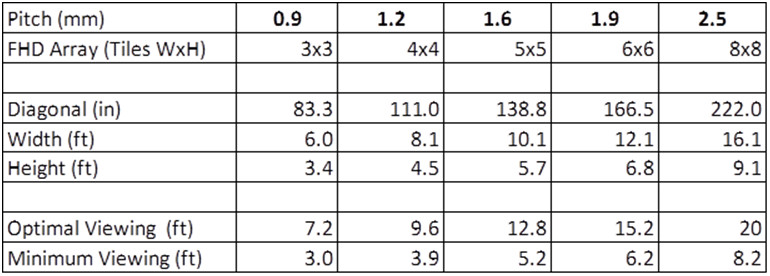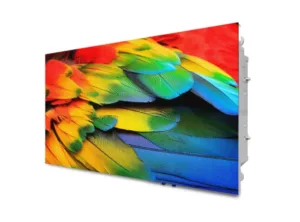Christie has added a new 0.9mm pitch model to their Apex lineup of LED video walls. They are not the first to commercialize 0.9mm cabinets as they wanted to be sure they could deliver top level quality consistent with their Apex brand of LED video walls.

The new 0.9mm cabinet/tile has a resolution of 640×360 in a 16:9 aspect ratio and a footprint of 24.2” x 13.6” (27.6” diagonal). It joins others in the Apex series with pixel pitches of 1.2, 1.6, 1.9, and 2.5mm. All of these are positioned as premium product solutions because of the technical specs, quality, features and service options offered by Christie.
We wanted to learn a little more so we had a conversation with Ted Romanowitz, senior product manager at Christie. Let’s start with the specs. For starters, the pixel pitch of this new model is actually 0.96mm. Each pixel is made up of individual RGB dies in a SMD package – so it’s ‘conventional’ LED wall technology (i.e. not COB or micro/miniLED).
The Surface Mount Device (SMD) is actual 0.6×0.6mm which means the emitting surface area is a large percentage of the area (high fill factor). Romanowitz says that high fill factor is good as it reduces moiré and works much better for broadcast applications. Others, like Sony, will argue that small fill factor with lots of black with offer better contrast (like their Crystal LED display). Romanowitz did not dispute this but noted his firm does use SMDs with a black surface technology to help improve contrast.
Romanowitz also said that they use much tighter binning and batching method than most of their competitors to ensure a tighter range of tolerance in the red, green and blue LED wavelengths. This not only allows for a bigger color gamut but much better uniformity and easier calibration. The color gamut is quoted as 100% of NTSC (yes, these markets still use this metric) with a calibrated uniformity in brightness and color of 97% – which is excellent. Peak luminance is 800 cd/m², also higher than competitors in the 0.9mm class of products. The tiles are also front serviceable (magnetically attached), another differentiator from competitors.
Where Will They Go
Where are 0.9mm LED walls being targeted, we asked? Romanowitz said they are being sold into executive boardrooms, situation rooms, control rooms, visualization and retail applications – anywhere where closer-in viewing is the norm.
Christie is also trying to take a turn-key approach to selling its Apex video wall. As a result, they now offer complete packages that include the LED video wall, mounting strictures, controller, power supplies and all cabling, plus spare tile spares (typically 5%).
They are also trying to simplify the design process. Often they find that customers want exact resolutions like FHD or UHD. For example, creating a FHD LED video wall with the 0.9mm pitch product requires a 3 x 3 wall with a screen diagonal of 83”. Using a 1.6mm pitch tile (same tile size as 0.9mm but resolution drops to 384 x 216) requires a 5×5 set up resulting in a 139” diagonal wall. The table below summarizes this and other configurations for FHD resolution.

The next question they ask is if the customer has a specific viewing distance requirement or screen size requirement. Romanowitz says they have a rule of thumb that the optimal viewing distance (in feet) is 8X the pixel pitch (in mm). As a result, a 1.6mm pitch screen is best viewed at 13 feet (4m) while a 0.9mm pitch screen is optimally viewed at 7.2 feet (2.2m). He defined optimal as the distance where you can’t see pixels anymore (we presume based on 20/20 visual acuity). But, he also defined a minimum viewing distance as well (presumably for those with better eyes). That is 3’ (0.9m) for the 0.9mm pitch and 5’ (1.5m) for the 1.6mm pitch.
These three factors – resolution, screen size and viewing distance should then determine the most suitable pixel pitch. Then, there is the question of price. Interestingly, Romanowitz said that the full bundle pricing between the various pixel pitches varies by only about 20%. After all, a FHD or UHD screen has the same number of pixels, but with smaller pitches, the cost of the LEDs and integration will be higher, but you need fewer tiles, cables, structure and power suppliers, so perhaps that balances out for larger pixel pitches where the LEDs cost less, but there are more other tiles, cables, etc.
Remote Power for Mission Critical Applications
The Apex line also features remote power supplies so that these and all the signal management and distribution can be located remotely in a utility closet. This makes for easier servicing should that be required. This can be up to 100 meters away. Power is delivered to the LED video wall over low voltage (48 VDC) cable. One trade off with remote power supplies is the power and signal losses over long distances. Romanowitz said the low voltage DC losses are modest, but the ability to have redundant and hot swappable power supplies is very important for mission critical applications. Signal is delivered via copper or fiber based Ethernet protocols.
We asked also about the linearity and uniformity of the gray scale and luminance at low light levels. Romanowitz says it is quite good and the specs are available upon request from customers. This is particularly important in control rooms and situation rooms where the room is darker and the peak luminance is limited to perhaps 300 cd/m², but where they need to see details in the shadows.
Finally, Christie also has a leasing option for their LED video walls in case the customer does not have all the money upfront. This particularly handy if a client wants to roll out a large number of sites in a short period, for example. Leasing also allows for upgrades later, but the program can’t be used to finance a purchase (or lease to buy).
Expect to start to see these new 0.9mm video walls at upcoming trade shows such as ISE. – CC

